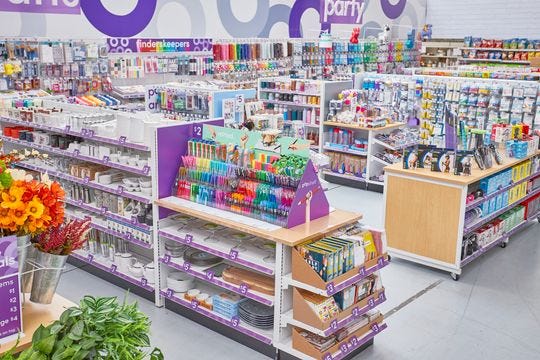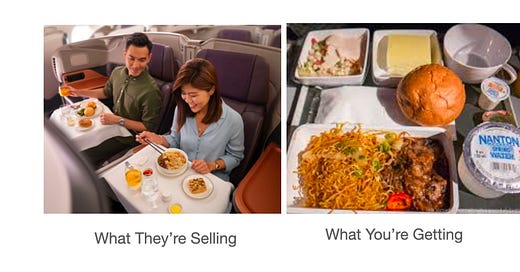Desperate times call for...
Tippets by Taps #150: Plane food, Dollar General, vending machines, the NBA bubble, and more. Enjoy!
Happy Sunday! I hope this finds you safe, healthy, and able to find some downtime this weekend. A very warm welcome to the new Tippets readers who are getting this for the first time! If you're reading this, not yet subscribed, and looking to receiving Tippets alongside the other similarly curious, intelligent people who've already subscribed, click below! 😄
I have to applaud the airline industry. A global pandemic has decimated travel and has forced a unique kind of creativity to keep the lights on. A few weeks ago we talked about the flights to nowhere, the “flights that take off and return to the airport a few hours later allow airlines to keep staff working.” Well, it turns out that wasn’t going to cut it for Singapore Airlines. They have abandoned their flight to nowhere plan and instead decided to roll out…airplane food restaurants.
For just two days, the A380 will play host to Singapore Airlines guests to enjoy a full inflight dining experience on the ground. Diners can pick their cabin class and enjoy the attentive service of SIA’s flight attendants while being served the airline’s signature international dishes onboard the plane.
To complement the experience, the airline staff will be wearing a showcase of cabin crew uniforms from the past. Diners are encouraged to turn up sporting traditional heritage attire, which the airline says can range from sarongs and sarees to a kilt. Those making the effort will get a special gift from the airline.
Before the meal, diners are invited to an exclusive tour of the A380. The carrier promises even to reveal some of the private access areas not usually seen by passengers. Guests can also enjoy a couple of alcoholic drinks on the house and a free flow of other drinks while dining. The IFE will be all fired up to provide the full selection of over 1,000 entertainment options, including movies and music.
Now let me make one thing clear. I think Singapore Airlines is the best airline on the planet. Their service is incredible, their inflight entertainment options are always top-notch, and they will always have a soft spot in my heart for being the first airline I ever flew that gave me my own screen and remote (as a kid, talk about a 🤯 experience). But paying for the pleasure of eating foil-covered chicken or pasta, presented with a plastic-bag wrapped bread roll, next to a side of shriveled, yellow-green leaves of lettuce and two cherry tomatoes that at 30,000 feet passes for a salad, complete with Danone biscuits for dessert, all while presumably sitting next to a stranger in economy class during COVID-19 without ending up anywhere else?

I don’t care how well Singapore has done fighting COVID, how many free drinks you get as part of the experience, or how magical the tour of the new A380 is. Unless the ‘special gift’ from SQ is free tickets (plural), subjecting oneself to plane food on a plane that literally is going nowhere feels like a desperate measure too far. That said, it’s 2020 and people are yearning for something different, so maybe this is a stroke of genius. Either way, we’ll find out in a few weeks. I will say this: if Singapore Airlines food ends up on UberEats you’ll know whoever is running this simulation we’re living in has a very peculiar sense of humor.

[To my darling parents who live in Singapore, as I told you on WhatsApp this week, you’re NOT allowed to go to this 😅]
Taps’ Note: According to this piece on the Straits Times published 30 minutes after I hit publish, “more than 900 seats that were available for Singapore Airlines' (SIA's) Restaurant A380 @ Changi dining experience were sold out within 30 minutes after bookings opened on Monday (Oct 12).” So there you have it…🤦🏽♂️😅
Dollar General to Open Stores Aimed at Wealthier Shoppers
Large, well-capitalized, ‘essential’ retailers have thrived during COVID. Dollar General is no exception. The discount retailer is an exceptionally well-run establishment and has been rewarded for it. Same-store sales are up 20% y-o-y and its stock price is up almost 40% since the beginning of 2020. Now, the chain is best known for its low-priced items with a core customer persona of “women from households earning roughly $40,000 a year” are making a move up-market.
The company plans to open a new brand of stores called Popshelf that mostly sells things shoppers don’t need but might want, such as party supplies, home decor or beauty products.
Dollar General expects even cash-strapped shoppers to like the idea of “treating themselves without the guilt associated with overspending,” said Emily Taylor, Dollar General’s executive vice president and chief merchandising officer.
Many of the categories Popshelf will sell have experienced an uptick in sales during the pandemic, such as home decor, and shoppers are likely to be hunting for bargains in a weakened economy, she said.
According to the company, the plans for Popshelf have been in the works for a few years but, as with other industries seeing accelerating trends during COVID, “the need for this store is very relevant now and maybe increasingly so.” It’s a worthwhile experiment for the business which will learn a lot about the changing nature of their markets. Dollar General will be opening two Popshelf locations in the coming weeks near the HQ in Nashville, TN with a stated goal of 30 by the end of the year. 30 might seem like a lot, but when you consider there are over 16,000 Dollar General stores nationwide, it’s clear that this is a first test, not a full-blown change in strategy.

The economics of vending machines
If you’re looking for a side hustle, vending machines might be the way to go. This article in The Hustle is a fascinating look at the economics of vending machines. Some fun facts:
⅓ of the world’s ~15m vending machines are located in the US
Of the 5m US vending machines, ~2m are currently in operation and do $7.4B in annual revenue
No single entity owns more than 5% of the market
An operator can find a decent machine and buy inventory for <$2k
Location is everything, and the cost to place a vending machine in a prime location can be for anywhere between 10%-25% of gross sales


A farewell to the NBA bubble after three grueling and exhilarating months
The NBA season concluded today with a familiar sight: the Los Angeles Lakers raised the Larry O’Brien championship trophy for the 17th time in NBA history, tying the Boston Celtics for the most ever, and adding another accomplishment to Lebron James’ growing legacy. That’s where ‘normal’ ends in a season that has been anything but.
For me (and many around the country and the world), the NBA suspending its season on March 11 was the signal that COVID was real and something to take very seriously. Since then, amongst the chaos and catastrophe that has been 2020, the NBA has done something truly remarkable: created a bubble, brought teams, coaches, owners, reporters back, and concluded the season without a single case of COVID disrupting the play.
This Washington Post article summed it up well:
For all its challenges, the bubble worked. No one has died. No players have gotten sick. No games have been canceled. That will be the restart’s legacy. The bubble was an impressive public health achievement at a time when the United States desperately needed one, and it should stand as a model for what can be done when immense resources are deployed thoughtfully, in good faith and in line with medical and scientific recommendations.
The bubble was the NBA’s moonshot, and it was executed with extraordinary attention to detail. The story behind the bubble deserves its own documentary, and hopefully it will get it.

Welcome to Prefab’s Moment
A few months ago I wrote about COVID’s impact on construction, in particular how modular / prefab construction (think Legos for buildings) was going to see a significant increase in demand as “any opportunity to shift toward a model that provides more flexibility, control, and safety for those on the front line is well worth considering.” Early signs suggest I was correct.
As people rush to build larger homes, second homes, or additions to existing homes, demand is spiking for what are often considered faster, cheaper, more flexible, and more predictable building methods.
An April report by market research firm Arizton predicted that the prefabricated building market would grow at about 8% a year between 2020 and 2025. But the recent demand for new housing has given it a push. From tiny firms to large corporations, architects and builders employing prefab say that inquiries have increased substantially since COVID-19 struck.
“So far we’ve seen a 50% increase in contracts between this year and last year,” says Steve Glenn, CEO of Plant Prefab, a Santa Monica, California–based company that works with architects to produce a large line of prefab residences including Accessory Dwelling Units (ADUs), single-family homes, and multifamily projects.
At Brooklyn-based design-build company FullStack Modular, where inquiries have risen about 30–35% since COVID-19 broke out, president and founder Roger Krulak says that new work is starting to come in in major cities, where land is getting cheaper, and thus stuck-in-their-ways developers are finally becoming willing to take a chance on what is still not standard practice.
Prefab is still a long way away from becoming the majority means of construction but certainly looks to be gaining traction as COVID continues without a clear end in sight.

Quote I’m thinking about: “Leadership is about empathy. It is about having the ability to relate to and connect with people for the purpose of inspiring and empowering their lives.” - Oprah Winfrey
If you have feedback on anything mentioned above or have interesting links/papers/books that you think would be worth sharing in future issues of Tippets, please reach out! Click the feedback link below, reply to this email, or DM me on Twitter at @taps.



